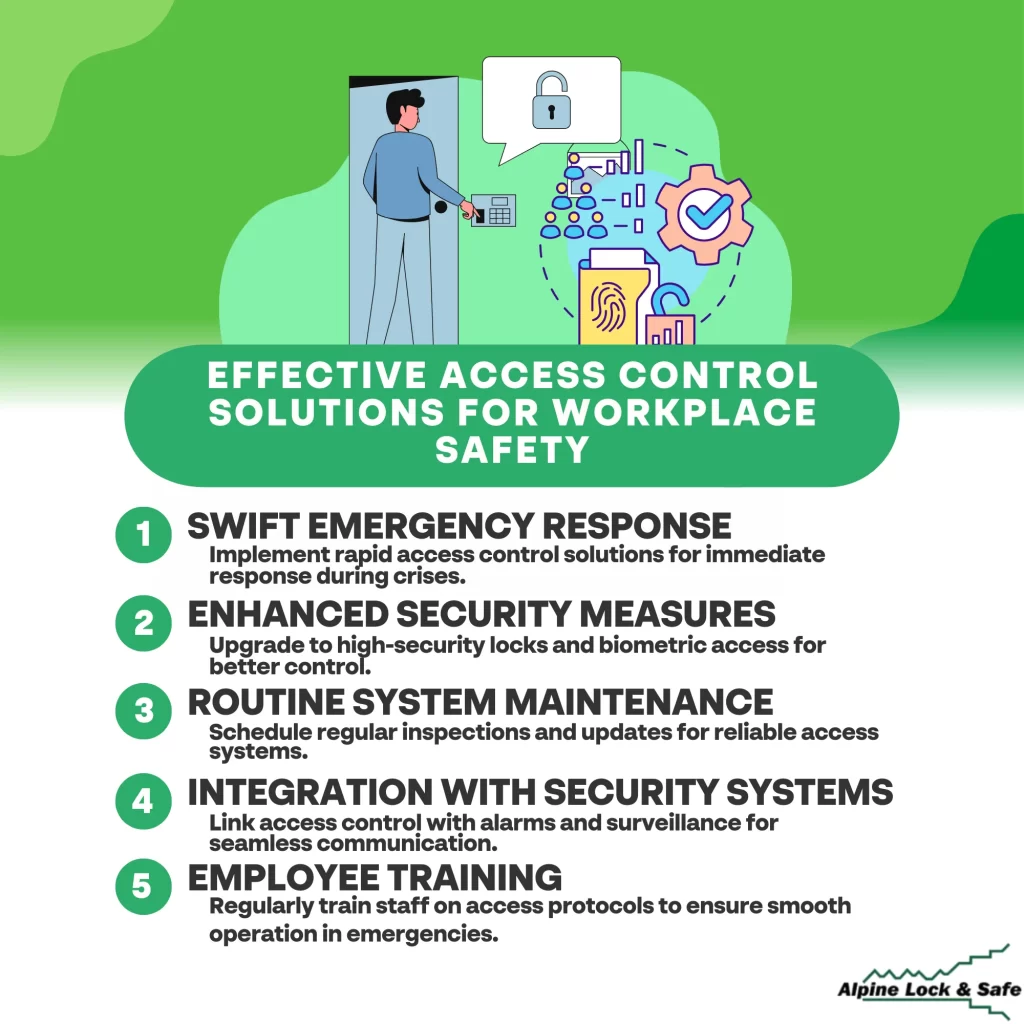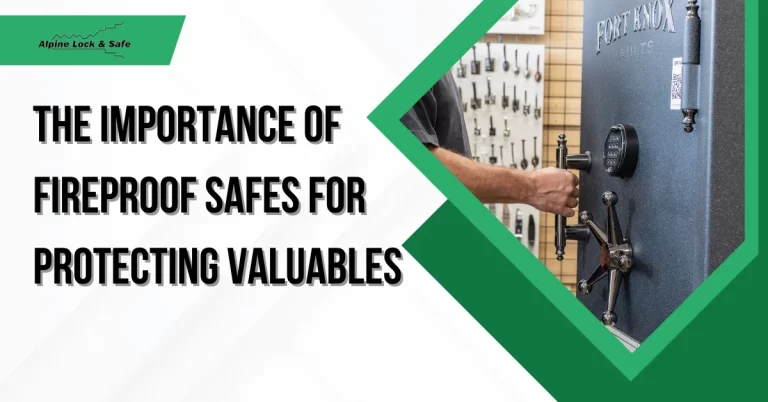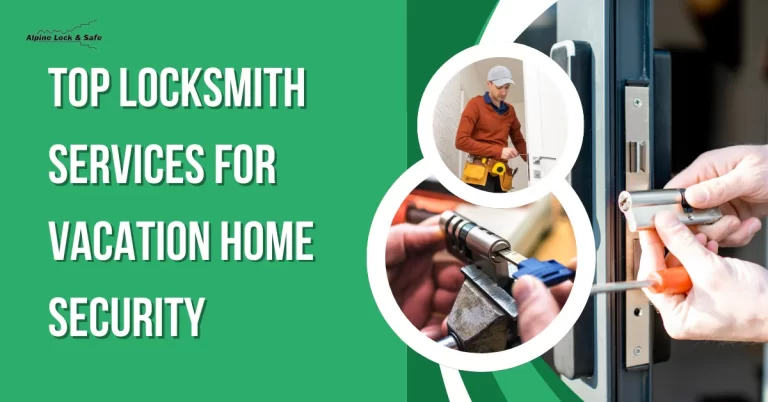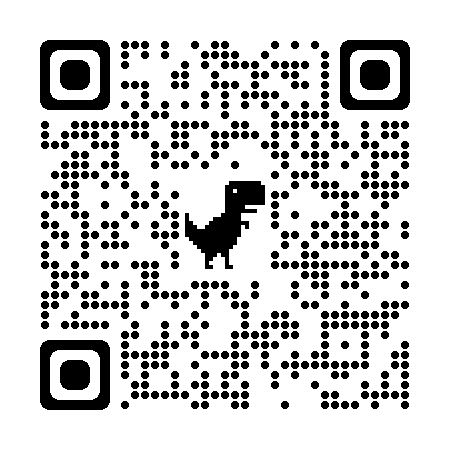Swift access control solutions are crucial for managing emergencies effectively. These systems guarantee that only authorized personnel can access secure areas, which streamlines emergency responses and maintains safety. You can choose from physical options, like locks and keys, or electronic systems that offer features like biometric access and remote control. Emergency locksmith services provide rapid support, assuring you regain access promptly when needed. By integrating these systems with other security measures, you’ll improve communication and coordination during crises. If you want to discover additional strategies for enhancing access control, keep exploring further information on this topic.

Key Takeaways
- Implement integrated electronic access control systems for seamless operation during emergencies, steamliningcommunication between security components.
- Utilize emergency locksmith services for rapid assessment and lockout resolution, ensuring quick access without property damage.
- Prioritize employee safety through regular training and drills focused on emergency protocols and access control measures.
- Schedule routine inspections and preventative maintenance for access control systems to ensure reliability and effectiveness.
- Employ real-time monitoring and alerts to enhance reaction times and coordination among security personnel during crises.
Importance of Access Control
Access control plays a critical role in guaranteeing safety and security during emergencies. When an urgent situation arises, having the right access rights in place is essential.
You want to make sure that only authorized personnel can enter sensitive areas, protecting both people and assets. This helps prevent chaos and guarantees a quick response to emergencies.
Upgrading to high-security locks can further enhance your access control measures, providing enhanced protection against break-ins to deter unauthorized access during critical times.
Implementing effective security protocols assures that your facility remains secure at all times. By setting up clear access controls, you can manage who gets in and who stays out, even during high-pressure situations. This not only safeguards your staff but also minimizes risks associated with unauthorized access.
You can feel confident knowing that with proper access control measures, you’re taking proactive steps to enhance safety. Regularly reviewing and updating your security protocols guarantees they remain effective and relevant.
In an emergency, every second counts, and having a reliable access control system in place can make all the difference. By prioritizing access rights and adhering to security protocols, you’re creating a safer environment for everyone involved.
Types of Access Control Systems
When it comes to access control systems, you’ve got two main types to evaluate: physical and electronic.
Physical access control includes locks and security personnel, providing a tangible barrier to unauthorized entry.
On the other hand, electronic access control uses technology like key cards and biometric scanners, offering convenience and enhanced security for your needs.
For instance, upgrading to a smart lock system can provide remote control access and individual passcodes, further enhancing security and convenience.
Physical Access Control
Physical access control systems play an essential role in safeguarding facilities by managing who gets in and out. You’ll find various types of physical access control, each tailored to meet specific security needs.
One effective method is biometric authentication, which uses unique physical traits, like fingerprints or facial recognition, to grant access. This technology guarantees that only authorized personnel can enter sensitive areas, offering a high level of security.
Another key aspect of physical access control is temporary access. This feature allows you to grant limited access to visitors or contractors for a specific time frame. By using access cards or keys that expire after a set period, you can maintain control over who’s in your facility without compromising security.
Implementing these systems not only protects your assets but also enhances overall safety. You can reduce the risks associated with unauthorized entries, creating a more secure environment for everyone.
With the right physical access control solutions, you’ll have peace of mind knowing that your facility is well-protected. So, consider investing in these systems to guarantee a secure and efficient access management process for your organization.
Electronic Access Control
In today’s security landscape, electronic access control systems have become essential for managing entry to facilities. These systems offer flexibility and advanced features that traditional methods can’t match.
You can choose from various options, like biometric systems that use fingerprints or facial recognition for secure access.Plus, mobile credentials let you use your smartphone to gain entry, making it easy and convenient.
Cloud management enables you to control your access systems from anywhere, while remote monitoring keeps you informed about who’s entering and exiting your facility in real-time.
With user permissions, you can customize who’s access to specific areas, ensuring security tailored to your needs. Access logs provide a detailed history of all entries, essential for security audits and compliance.
System scalability is another advantage, allowing you to expand your access control as your organization grows. You can start small and add more features over time, minimizing upfront costs.
Emergency Locksmith Services
Emergencies can strike at any moment, leaving you barred from your home or vehicle and feeling frustrated. That’s where emergency locksmith services come in.
These professionals are equipped with the latest locksmith techniques to get you back on track quickly and safely. With years of experience and access to expert knowledge and experience, you can expect a high level of service.
Here’s what you can expect when you call for help:
- Rapid Assessment: A skilled locksmith will evaluate your situation to determine the best approach.
- Expert Lock Picking: Using advanced locksmith techniques, they can gain access to doors without damaging your property.
- Replacement Services: If a lock is broken, they can provide immediate lock replacement to secure your space.
- Emergency Preparedness Tips: They’ll offer advice on how to avoid future lockouts, helping you stay prepared.
Whether you’re facing a home or car lockout, these services are invaluable.
Rapid Response Times
When you find yourself locked out, every minute counts, and that’s where rapid response times make all the difference. You need a service that can get to you quickly, guaranteeing you’re not left waiting and feeling stressed. With options like rapid deployment, you’ll discover professionals who prioritize your needs and can arrive at your location in no time.
Real-time monitoring systems are also a game changer. They allow service providers to track their team’s movements and arrival times, guaranteeing you’re updated throughout the process. This means you won’t be left in the dark, wondering when help will arrive. Instead, you’ll have the reassurance that assistance is on its way.
The combination of rapid response and real-time monitoring creates a smooth experience when emergencies strike. You can feel confident knowing that reliable services are just a call away, ready to restore your access swiftly.
Integration With Security Systems
Integrating access control solutions with existing security systems can streamline your emergency response and enhance overall safety. By focusing on security integration and system interoperability, you create a cohesive environment that reacts swiftly to incidents.
Here are four key benefits to evaluate:
- Improved Communication: Linking access control systems with alarms and surveillance can guarantee all security components work together seamlessly, allowing for rapid information sharing during emergencies.
- Centralized Management: With integrated systems, you can manage access points and security features from a single interface, making it easier to monitor and respond to threats.
- Real-Time Alerts: An integrated system can send immediate alerts to security personnel when an access point is compromised, enhancing your ability to react without delay.
- Data Sharing: Interoperability between systems allows for the sharing of essential data, such as access logs and video feeds, which can be significant during an emergency.
Enhancing Employee Safety
Employee safety is a top priority for any organization, especially during crises. To enhance safety, you should invest in thorough employee training and regular safety drills.
By equipping your team with the right knowledge and skills, you’re not just meeting compliance standards; you’re also creating a culture of safety that empowers everyone.
Consider implementing training sessions that focus on emergency protocols and the specific access control measures in place. This guarantees that all employees know how to respond when an emergency arises, minimizing confusion and potential hazards.
Regular safety drills can reinforce this training, allowing employees to practice their responses in a controlled environment. When employees feel prepared, their confidence grows, which can lead to quicker, more effective reactions during actual emergencies.
Additionally, having a clear communication plan can enhance coordination among staff, guaranteeing everyone knows their role and responsibilities. Incorporating these strategies not only protects your employees but also strengthens your organization’s overall resilience.
Prioritizing employee safety during emergencies demonstrates your commitment to their well-being, fostering trust and loyalty in your workplace. Take action today to create a safer environment for everyone.
User-Friendly Access Solutions
Creating a safe and prepared workplace not only involves training but also ensuring that access control solutions are user-friendly.
When you implement intuitive designs, you enhance the user experience, making it easier for everyone to navigate emergency situations.
Here are four key features to evaluate for a more user-friendly access control system:
- Simple Interface: A clear, uncluttered interface allows users to quickly understand how to operate the system, reducing panic during emergencies.
- Mobile Accessibility: Make sure your access solutions work seamlessly on mobile devices, so users can gain access from anywhere, even in unexpected situations.
- Clear Instructions: Provide straightforward instructions that are easy to follow, ensuring everyone knows what to do when seconds count.
- Regular Updates: Keep the system updated with the latest technology and features, ensuring it remains intuitive and effective for all users.
Preventative Maintenance Tips
To keep your access control systems functioning smoothly and reliably, regular preventative maintenance is vital. Start by scheduling routine inspections at least twice a year.
During these inspections, check all hardware components, like locks and sensors, for wear and tear. Addressing minor issues before they become major problems can save you time and money.
Don’t overlook software updates, as these can enhance system performance and security. Make certain your access control system is equipped with the latest features by performing regular system upgrades. This not only improves efficiency but also protects against potential vulnerabilities.
You should also consider cleaning all components, as dust and debris can hinder performance. Make it a point to test each access point regularly, confirming that everything works seamlessly. And, if you notice any unusual behavior, act quickly to prevent any disruptions.
Lastly, keep a detailed maintenance log. This will help you track inspections, repairs, and upgrades, providing valuable insights into your system’s health.
Choosing the Right Locksmith
When you’re in an emergency, choosing the right locksmith can make all the difference.
You’ll want to assess their qualifications, evaluate how quickly they respond, and understand their service costs.
These steps will help guarantee you get the reliable help you need when it matters most.
Assessing Locksmith Qualifications
Choosing a qualified locksmith is crucial in guaranteeing your property’s security, especially during emergencies. You want someone with the right skills and credentials to handle your needs effectively.
Here are four key factors to regard when evaluating locksmith qualifications:
- Locksmith Certifications: Look for locksmiths who possess certifications from recognized organizations. These certifications show they’ve undergone proper training and adhere to industry standards.
- Experience: Reflect on how long the locksmith has been in business. Experienced locksmiths are usually more adept at handling a variety of situations and complexities.
- Insurance and Bonding: Verify the locksmith is insured and bonded. This protects you from any damages that might occur during their work.
- Customer Reviews: Check online reviews and testimonials from previous clients. Positive feedback can give you confidence in their reliability and service quality.
Evaluating Response Time
Understanding how quickly a locksmith can respond during an emergency is essential for your peace of mind. When you’re locked out or facing a security issue, every minute counts.
You should look into the locksmith’s response metrics, which indicate how fast they can arrive on the scene. A reliable locksmith should provide you with a clear estimate of their average response time based on previous incidents.
Conducting an incident analysis can be helpful. Ask potential locksmiths about their past experiences with emergencies similar to yours.
This will give you insight into how they handle different situations and their efficiency in getting the job done. You want someone who can tackle your problem swiftly and effectively.
Understanding Service Costs
Service costs can vary widely among locksmiths, so it’s crucial to get a clear picture before you need help.
When you’re faced with a lock emergency, understanding service pricing can save you time and money.
Here’s a quick cost analysis to guide you in choosing the right locksmith:
- Service Call Fee: Many locksmiths charge a fee just to come to your location, which can range from $25 to $100, depending on the time of day and your location.
- Labor Costs: Expect to pay hourly rates for labor, typically between $50 and $150. This can increase for complex locks or late-night services.
- Parts and Materials: If you need new locks or parts, factor in additional costs. High-security locks can be considerably more expensive.
- Emergency Services: If you require immediate assistance, emergency service pricing can be 20% to 50% higher than standard rates.
Frequently Asked Questions
How Quickly Can Access Control Systems Be Installed During an Emergency?
When you’re facing an emergency, rapid deployment of access control systems is essential. You’ll find that with proper emergency preparedness, these systems can often be installed within hours, ensuring safety and security when it matters most.
What Are the Costs Associated With Emergency Access Control Solutions?
When you weigh installation expenses against long-term system maintenance, you’ll find that emergency access control solutions can vary greatly. It’s essential to budget wisely to guarantee both immediate safety and ongoing functionality.
Can Access Control Systems Function During Power Outages?
Yes, access control systems can function during power outages if they have battery backups. You can also use manual overrides to maintain access, ensuring security and control even when the power goes out unexpectedly.
Are There Mobile Apps for Managing Access Control Remotely?
You can access mobile app features like real-time monitoring and user management, making it easy to control access from anywhere.
How Can I Test My Access Control System’s Reliability Before Emergencies?
To test your access control system’s reliability, conduct system performance evaluations regularly. Simulate emergencies, check response times, and guarantee all components function correctly. This proactive approach helps identify weaknesses before real situations arise.
Conclusion
In emergencies, swift access control solutions can be your lifeline. By choosing the right system and locksmith, you’re not just securing your space; you’re ensuring peace of mind for yourself and your employees. With rapid response times and reliable service, you can face any challenge confidently. Don’t wait—take action today to protect what matters most and keep your environment secure.






